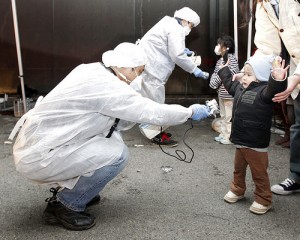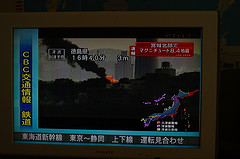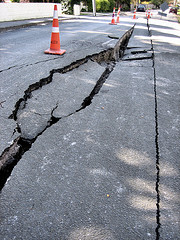Posted on 15 April 2011. Tags: chief cabinet secretary, evacuation zone, geological survey, magnitude earthquake, nuclear reactors, pregnant women, radiation exposure, state television, tokyo electric, yukio
 Japan widened its evacuation zone surrounding the quake-hit nuclear power plant due to increased levels of radiation, which have had accumulated, as a strong aftershock hit the area on Monday, a month after the devastating incident occurred.
Japan widened its evacuation zone surrounding the quake-hit nuclear power plant due to increased levels of radiation, which have had accumulated, as a strong aftershock hit the area on Monday, a month after the devastating incident occurred.
Tokyo and eastern part of Japan was shook with a 7.1 magnitude earthquake on Monday evening, which then triggered a small tsunami alert. State television said the aftershock caused an off-site power supply for the damaged reactors to shut down.
Geological survey conducted by the United States said that the aftershock hit 38 kilometers (24 miles) west of the Iwaki city at a depth of 14 kilometers (8 miles).
Workers at Tokyo Electric Power Co had ceased pouring cooling waters on reactors no. 1, 2 and 3 at the Fukushima power plant.
Families living in towns and villages outside the 20 kilometer evacuation zone, where more radiation have had accumulated, would be evacuated, according to Chief Cabinet Secretary Yukio Edano. He said hospitalized patients, children and pregnant women should avoid the area within 20-30 kilometers from the Fukushima complex.
Also, Edano said that the decision to expand the evacuation area was based on the data analyzed from the accumulated radiation exposure information. He said the evacuation precautions are meant to secure the safety of the people who might live in the area for 6 months to one year. However, it is not necessary to evacuate immediately, he added.
Previously, Japan did not agree to the proposed plans to extend the evacuation zone despite concerns from neighboring countries regarding the radiation that might spread from the damaged nuclear reactors at Fukushima.
Posted in Nation and World
Posted on 07 April 2011. Tags: aftershock, broadcasters, kilometers, magnitude earthquake, miyagi prefecture, previous tsunami, public news, quake, tsunami warning, western suburbs
 Japan was yet again rattled by a 7.4 magnitude earthquake, Thursday night. A tsunami warning was immediately announced after the quake was felt.
Japan was yet again rattled by a 7.4 magnitude earthquake, Thursday night. A tsunami warning was immediately announced after the quake was felt.
Broadcasters of Japan’s public news network told people living in the northeastern shore of the country to evacuate to higher grounds and as far away from the shore as possible. One hour after the quake hit Japan, no tsunami was observed hitting the shore.
Officials of Fukushima Dai-ichi nuclear plant (a nuclear plant that is still managing the damages caused by the previous tsunami that hit Japan barely a month ago) said that they see no immediate signs of additional problems from the recent quake. No one in the plant was injured as the workers were immediately relocated to a quake-resistant area inside the complex.
Government officials said that the aftershock hit 50 kilometers off the coast of Miyagi prefecture. Buildings in Tokyo shook for as long as a minute. In Ichinoseki, a place closer to the Miyagi prefecture compared to Tokyo, shelves and furniture were knocked out. Right after the quake, electrical supply to that area was cut to prevent accidental fires.
The earthquake shook Japan at 11:32 in the evening, local time. A little earlier than that, Japanese TV already announced a warning for a possible quake and loudspeakers warned residents of the western suburbs in Tokyo.
Experts are not expecting an ocean-wide tsunami but they emphasized that quakes that strong may cause local waves that can cause vast damages.
Posted in Featured News, Nation and World
Posted on 04 April 2011. Tags: earthquake in the indian ocean, higher grounds, magnitude earthquake, massive earthquake, pacific tsunami warning, pacific tsunami warning centre, seismologist, seismologists, tsunami alert, us geological survey
 A strong 6.7 magnitude earthquake hit the southern part of Java, Monday. Many residents fled from the Indonesian port to look for higher grounds due to fear of an impending tsunami.
A strong 6.7 magnitude earthquake hit the southern part of Java, Monday. Many residents fled from the Indonesian port to look for higher grounds due to fear of an impending tsunami.
The epicentre of the earthquake in the Indian Ocean was 15 miles deep, said the US Geological Survey.
Seismologists in India placed the earthquake on magnitude 7.1 and announced a tsunami alert, saying that the strength of the tremor can potentially cause a gigantic wave. They sent a public alert SMS and asked the citizens to forward the said SMS to as many people as possible. The tsunami alert was cancelled eventually.
The earthquake, paired with the government’s tsunami warning, caused a lot of fear and panic among the people living in the seaport town of Cilacep. They were apparently, all shouting “quake, quake!”
Suharjono, Meteorology and Geophysics Agency technical head, said that the tremors were felt in Cilacep and Pangandaran. He further said that the earthquake had woken up people from sleep but they did not receive reports of casualties.
The US Pacific Tsunami Warning Centre already said that there are no risks of a huge wave, but there is a very slight chance of a local tsunami.
David Jepson, Australian seismologist, said that they received reports that the quake was felt in Christmas Island – a remote island that is a part of the Australian territories. The epicentre of the quake was 241 kilometers away from the island.
Geoscience Australia placed the earthquake on magnitude 6.7 but they did not release a tsunami warning.
Posted in Nation and World
 Japan widened its evacuation zone surrounding the quake-hit nuclear power plant due to increased levels of radiation, which have had accumulated, as a strong aftershock hit the area on Monday, a month after the devastating incident occurred.
Japan widened its evacuation zone surrounding the quake-hit nuclear power plant due to increased levels of radiation, which have had accumulated, as a strong aftershock hit the area on Monday, a month after the devastating incident occurred.
 Japan was yet again rattled by a 7.4 magnitude earthquake, Thursday night. A tsunami warning was immediately announced after the quake was felt.
Japan was yet again rattled by a 7.4 magnitude earthquake, Thursday night. A tsunami warning was immediately announced after the quake was felt. A strong 6.7 magnitude earthquake hit the southern part of Java, Monday. Many residents fled from the Indonesian port to look for higher grounds due to fear of an impending tsunami.
A strong 6.7 magnitude earthquake hit the southern part of Java, Monday. Many residents fled from the Indonesian port to look for higher grounds due to fear of an impending tsunami.